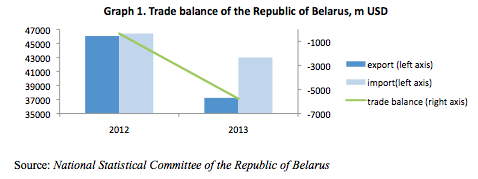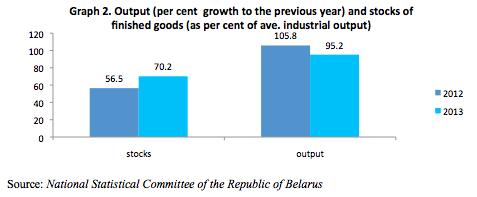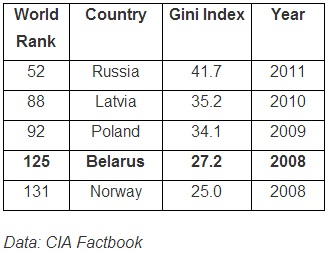Strict Monetary Policy to Solve Economic Problems – Belarus Economy Digest

According to official forecasts, an improved climate for foreign trade and accelerated economic growth await Belarus in 2014. The growth of the country's negative trade balance in 2013 created additional pressure on the foreign exchange market and the dynamics of its foreign reserves.
Improving the efficiency of the manufacturing sector remains one of the main objectives of economic policy. Officials plan on carrying out measures to stimulate the growth of industry and to reduce the stocks of manufactured goods.
In 2014 a strict monetary policy on the part of the National Bank will address the problems in the economy. The gradual decline in interest rates will occur by maintaining the profitability of ruble deposits. Changes in refinancing rates will depend on the rate at which prices grow. Furthermore, the National Bank will limit any rises in excessive financial lending.
Decline in foreign trade and growth of a negative balance
According to preliminary information of National Statistical Committee of the Republic of Belarus, foreign trade turnover was reduced by more than 13 per cent in 2013. Improvement in foreign trade is one of the priorities for the Belarusian economy. In 2013, positive trends in this field failed to achieve the results desired.
Over the previous year exports declined at a faster rate than imports. A negative trade balance in goods amounted to -$5.6bn or 8.1 per cent of nation's GDP. A positive trend in 2013 was seen with the expansion of foodstuff exports. Due to an increase in external sales of meat and dairy products, exports in this commodity group grew in comparison to the previous year.
At the same time the trade balance in the group of non-food consumer goods deteriorated and was, in the end, negative. Rapid income growth, including imported consumer goods, stimulated the population's consumption. The cessation of exports of solvents and dilutents, a reduction of potash fertiliser exports and the growth of enterprises' operating costs contributed to the growth of Belarus' negative trade balance.

The main trading partners of Belarus were the Russian Federation and the EU. It is noteworthy that in 2013 there was an increase in Belarusian exports to Russia with a simultaneous growth in imports from the EU. Traditionally, Belarus buys machinery, equipment and consumer goods from the EU. This trend, however is not prevalent with Russia, as Belarusian enterprises from the manufacturing sector supply their own goods to the Russian market.
The total balance of goods and services may obtain a positive balance and could equal 0.1 per cent of Belarus' GDP in 2014. This growth will become possible if there is an increase in the volume of Belarusian exports and a more moderate growth in its imports. A supposed augmentation in the exporting of petroleum products, potash fertilisers and food products may play a positive role in helping the economy develop in this direction.
Any significant results in the foreign trade arena depend on developments with real incomes, as well as any fluctuations of the Belarusian ruble against the currencies of its major trading partners.
High stockpiles of goods and low production volumes
The issue of overstocking remains one of the main issues of the Belarusian economy. In 2013, while there were decreasing production volumes, stocks of finished goods piling up in warehouses exceeded norms. For the entire year industrial output fell by 4.8 per cent. The greatest decline occurred in the petrochemical industry, publishing industry, metallurgy and the production of vehicles.
At the same time, year-end stocks against the average monthly production volume amounted to 70.2 per cent. In accordance with the predicted values, stocks were not to exceed 65 per cent of the monthly production volume until the end of the year. However, this was not what transpired in the end. In several industries, like textiles and clothing production, leather production, machinery and equipment, manufacturers built up substantial stockpiles of their goods and were unable to sell them on the market.
In 2013, difficulties in production and the sale of Belarusian products, both on domestic and foreign markets, led to the deterioration in the performance of its enterprises. Revenue growth and the profit margins of enterprises witnessed steady declines, and the total number of unprofitable enterprises increased.
Improved competitiveness for Belarusian manufactured goods, as well as the strengthening of foreign trade relations will foster the normalisation of the situation in the real sector. The unloading of stocks with growing production volumes will contribute to the improvement of the country's trade balance.

In January, the National Bank announced that in 2014 it would follow a strict monetary policy. This means that lower interest rates will occur gradually with consideration being made to preserving the profitability of deposits in the national currency. The dynamics surrounding the refinancing rate will depend on changes in prices in the economy.
The reduction of refinancing rates was halted back in June 2013. Its value has remained unchanged up until the end of February 2014. Monetary policy is one of the tools that may improve the situation with foreign trade and reduced inflation.
In 2014, the National Bank will pay particular attention to the growth rates of credit. In accordance with plans for 2014, the terms set for banks issuing credit should not increase more than 16-19 per cent. At the same time, this requirement applies to credit given both in national and foreign currencies.
In 2013, while maintaining high interest rates on ruble credits, enterprises preferred to receive them in hard foreign currency. By the end of 2013 more than half of the credit given to companies and enterprises accounted for lending in foreign currency. Very often companies were able attract credit for projects that did not provide any earnings in the form of hard currency. This fact created additional pressure on the foreign exchange market.
In order to stabilise the situation, the National Bank in January 2014 issued a resolution according to which banks may grant credit with foreign currency to enterprises only for payments to non-residents in foreign trade operations. Earlier restrictions applied only to short-term loans.
Belarusian enterprises could attract long-term loans for payments with both residents and non-residents. Restrictions on lending in a foreign currency, as well as the gradual reduction of interest rates on ruble lending should increase the share of ruble credits in the national bank’s overall portfolio.
Anastasiya Luzgina, Belarusian Economic Research and Outreach Center (BEROC)
This article is a part of a joint project between Belarus Digest and Belarusian Economic Research and Outreach Center (BEROC)



 The Gini
The Gini